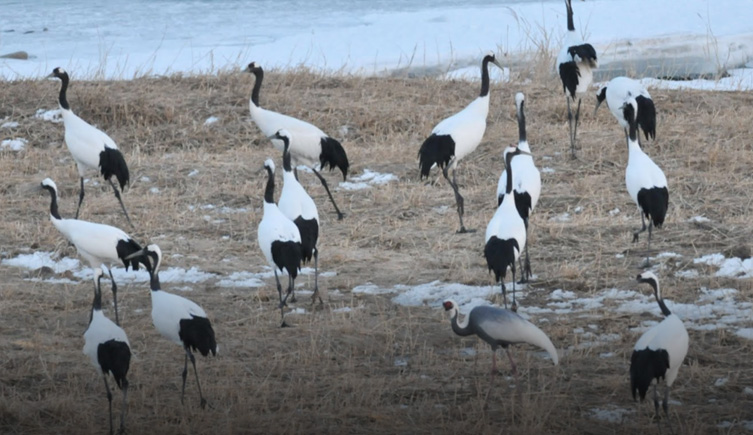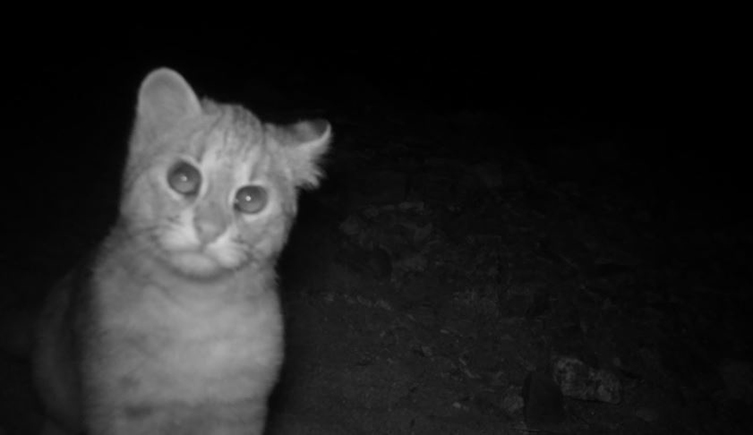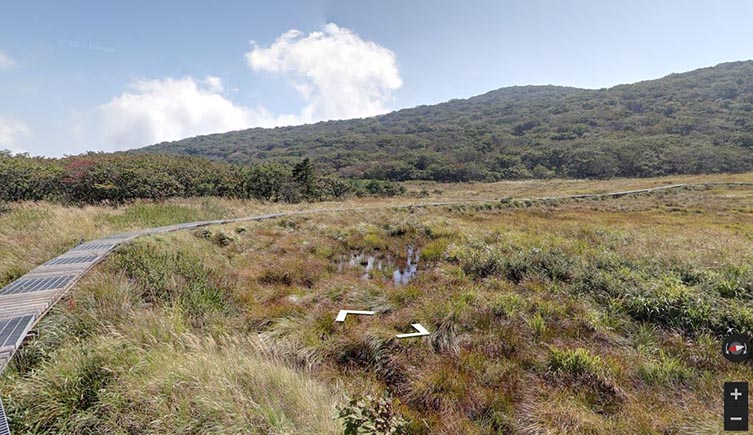One of the most heavily militarised borders in the world has become a haven for nature.
To mark 70 years since the end of the Korean War, Google has released rare images of the place where few people have been allowed to set foot.

Remote cameras caught footage of an Asiatic black bear, giving hope that this threatened species is breeding in the area. Image © National Institute of Ecology/Google Arts & Culture
One of the most heavily militarised borders in the world has become a haven for nature.
To mark 70 years since the end of the Korean War, Google has released rare images of the place where few people have been allowed to set foot.
Stretching for 250 kilometres along the border between North and South Korea is the demilitarized zone (DMZ), an area that was once the centre of conflict between the two nations.
Although the Korean war ended seven decades ago, most people are still prohibited from entering the site which is surrounded by high fences with land mines strewn across the landscape.
Yet, in the absence of human activity the environment within the DMZ has recovered, and nature has thrived there undisturbed for the past several decades.
Now it is a haven for animals rarely found in other parts of the Korean peninsula, including bears, cranes, deer and otters.

Red-crowned cranes are one of many species of crane found in the DMZ. Image © National Institute of Ecology/Google Arts & Culture
For the first time, people worldwide have been granted a rare glimpse into this restricted part of the world with 360-degree images of the landscape available on Google Street View.
The images were released on Google Arts & Culture to mark the anniversary of the 1953 armistice agreement.
The project is a collaboration with nine South Korea-based cultural institutions, including the DMZ Ecology Research Institute and the National Institute of Ecology, Seocheon, South Korea, which studies the environment within the restricted area.
Kim Seung-ho, the Head of DMZ Ecology Research Institute, told the Washington Street Journal: 'The DMZ region represents a sad history for the two Koreas. But it has been a rare haven for the many wildlife living there.'

The DMZ is home to an amazing range of wildlife rarely seen elsewhere on the Korean peninsular such as this curious wildcat. Image ©National Institute of Ecology/Google Arts & Culture
The North Korean military marched into South Korea at 04.00 on 25 June 1950, marking the beginning of the Korean War. The conflict raged across the peninsula, decimating the landscape and population as hostilities spread.
Three years later, on 27 July 1953, an Armistice Agreement was signed officially ending the war between the countries.
The DMZ was created as a buffer zone to e distance between North and South Korea and help prevent further conflict and maintain peace following the ceasefire.

Yongneup, the only high moor in South Korea, is a paradise for wetland plants. Image ©Google Arts & Culture
The zone stretches 250 kilometres east to west across the Korean peninsula, with a four-kilometre gap separating the borders of the two countries. It covers a vast area of about 907 square kilometres, equivalent to almost twice the size of New York City.
Since then, the area has been noted for its ecological importance and efforts have been made nationally and internationally to conserve nature within the DMZ. This has, however, proved tricky due to tensions that still exist between the two nations.

The Hantan River flows through South Korea's Gangwon and Gyeonggi provinces. Image © Google Arts & Culture.
Scientists researching the ecology of the DMZ are among the few people allowed to enter the area.
Wildlife surveys have found 6,168 species within eight areas of the DMZ. Of the 267 endangered species on the Korean peninsula, 102 have been recorded in the militarised zone.
As the DMZ is effectively a slice across the entire peninsula, it protects an extraordinary range of environments, from mountains and swamps, to lakes and tidal marshes.
The researchers have recorded long-tailed goral and musk deer inhabiting the rocky mountains, rare golden eagles dominating the skies, unique plants growing among the dense vegetation, and insects thriving in the rivers and forests.

It is not only mammals and birds that have been protected by the DMZ. The Mongolian racerunner lizard are thriving in the region. Image ©National Institute of Ecology/Google Arts & Culture
While the fences and mines might stop people, otters move freely along the river system spanning the borders of North and South Korea. Some now view them as a symbol of peaceful interaction between the two nations.
Remote cameras are also revealing some of the more elusive animals, such as wildcats and yellow-throated martens. In addition, an Asiatic black bear cub was caught on the cameras giving hope that this species, threatened due to poaching and habitat loss, is successfully breeding in the area.

Surveys by the DMZ Botanic Garden have also been recording the plants that live in the zone, such as Wilford swertia, a herb with violet flowers. Image ©DMZ Botanic Garden/Google Arts & Culture
There are even rumours that other large carnivores, such as tigers and leopards, might survive in the depths of the forests.
The absence of people has led to the DMZ becoming an important site for cranes. Seven of the 15 crane species in the world are found in Korea, including the red-crowned crane and white-naped crane, which are globally threatened with extinction. These birds have been found to overwinter in peace in the restricted zone.
Researchers from the DMZ Botanic Garden have also conducted site surveys and found several rare plants. These have included the rare orchid Pogonia japonica and the flowering plant, Patrinia saniculifolia, which is endemic to Korea and whose name means 'infinite love'.

Around 60 species of mammals have been recorded in the DMZ, including yellow-throated martens. Image ©National Institute of Ecology/Google Arts & Culture
The site provides a rare window into the natural landscapes of the peninsula that has been lost around the growing cities of South and North Korea.
Seo Jae-chul, an expert adviser at Green Korea United, says, 'Have you wondered what the Han River, which now cuts through the heart of Seoul, might have looked like in its natural state 100 years ago? You can see it at the DMZ, through the natural river banks and streams that are there.'
'My personal hope is that Korea's tragedy can be reimagined as an expression of humanity’s ecological vision, sooner than later.'

We're working towards a future where both people and the planet thrive.
Hear from scientists studying human impact and change in the natural world.
Don't miss a thing
Receive email updates about our news, science, exhibitions, events, products, services and fundraising activities. We may occasionally include third-party content from our corporate partners and other museums. We will not share your personal details with these third parties. You must be over the age of 13. Privacy notice.
Follow us on social media